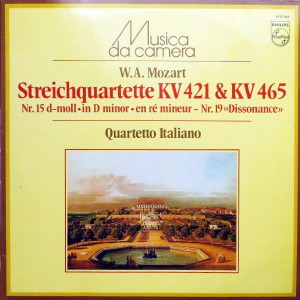 |
|
Philips
- 1 LP - 6570 888
|
|
QUARTETTO ITALIANO
- Paolo Borciani, Elisa Pegreffi, violino
- Piero Farulli,
viola
- Franco Rossi, violoncello |
|
|
|
|
|
Luogo e data
di registrazione |
|
ThÚÔtre
Vevey, Vevey (Svizzera)
- 14 agosto / 1
settembre 1966 |
|
|
Registrazione: live
/ studio |
|
studio |
|
|
Producer / Engineer |
|
Vittorio Negri |
|
|
Edizione LP |
|
Philips | 6570
888
| 1
LP |
|
|
Prima Edizione CD |
|
Vedi link alla prima
edizione in long playing.
|
|
|
Note |
|
La
collana
"Musica da
Camera" della
Philips
riedita negli
anni
'80
alcune
registrazioni
del Quartetto
Italiano. |
|
|
|
|
Between
the end of
1782 and the
beginning of
1785 Mozart
wrote six
string
quartets which
he dedicated
to Joseph
Haydn in a
letter which
has become
famous. They
are not only
some of his
most personal
works, but are
also amongst
the most
important in
Classical
chamber music.
They were
prompted by
the so-called
"Russian"
Quartets Haydn
had composed
in 1781 and
had said were
written "in a
quite special
new way." This
new element
was the
synthesis
between
polyphony and
"thematic
treatment,"
the principle
of obbligato
part writing
which allows
all four
instruments to
have an equal
share in the
musical
discourse. It
was in this
set of
quartets by
Haydn that
this principle
had succeeded
completely for
the first
time. Even if
the deep
impression
they made on
Mozart was
reflected not
merely in his
dedication to
his model,
Haydn, but
also in the
treatment of
the music,
Mozart
nonetheless
speaks his own
unmistakable
language which
even struck
some of his
contemporaries
as being
strange.
A
work such as D
minor Quartet,
K. 421 evokes
impressions
which suggest
Schubert
rather than
Haydn. The
dark
melancholy
mood which
permeates the
wohle
work is
brightened on
a single
occasion only,
namely in the
serenade-like
trio of the
otherwise
gruff,
polyphonically
treated
minuet. The
difference
between Mozart
and Haydn is
felt most
clearly in the
finale, Mozart
writes
variations
with a coda on
a Siciliano
theme, as
Haydn had done
also in one of
his "Russian"
Quartets. The
Siciliano
nevertheless
changes the
mood to one of
hopeless
fatalism and
resignation
and does not
even confer on
the close any
major key
brightening.
On the
contrary, the
inner state of
agitation
which pervades
the movement
seems almost
to explode in
the final
triplets
emitted by the
violin. The Andante
is admittedly
in F major,
but its
hesitant,
Schubertian cantabile
mature is
stamped by an
inscrutable,
resigned
wistfulness,
thereby
serving as the
means for the
sublimation,
that "hidden"
chromaticism
so
characteristic
of Mozart,
which pervades
the whole
work. The
extensive
first movement
with its
broadly spaced
main subject
and excited
development is
also marked by
this dark and
personal mode
of expression.
Of
a completaly
different
character and
much more
relaxed is the
C major
Quartet, K.
465. It is the
only one of
Mozart's
quartets to
begin with an
Adagio
introduction,
the bold
harmonic and
long
misunderstood
false
relations of
which gained
for the work
the nickname
"Dissonance."
In the broadly
planned Allegro
of the first
movement,
which served
as a model for
Beethoven in
his famous F
major Quartet,
Op. 59 No. 1,
these
complications
linger merely
in outline,
mainly in the
development
which
modulates the
exposition
energetically.
The F major Andante
begins with a
tender cantabile
melody, but
the main
constructional
element in a
short motif
resembling a
sigh which
dominates the
music
completely and
is given
substance in
the
development
like middle
section of the
movement. In
spite of the
modulation of
the trio to C
minor, the
minuet has a
gay,
dance-like
character. A
carefree joy
in
music-making
also dominates
the finale,
this being
expressed
above all in
the rapid
virtuoso
passage of the
first violin
which appears
twice. This
does not,
however,
present Mozart
from
introducing
elaborate
fugato
complications
at the
beginning of
the
development.
Alfred
Beaujean
|
| Illustration:
Bernardo Bellotto (1720-1780)
"Schlo▀hof bei Marchegg
Gartenseite" (Kunsthistorisches
Museum, Wien) |
|